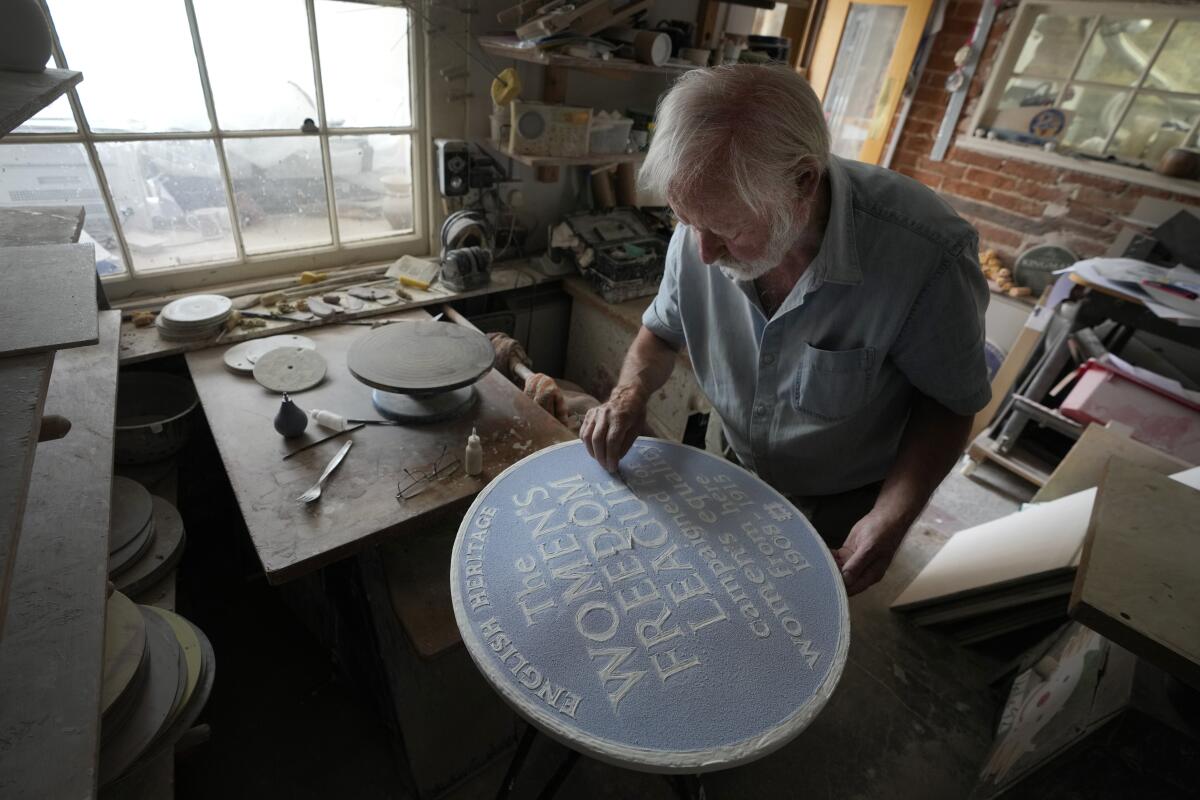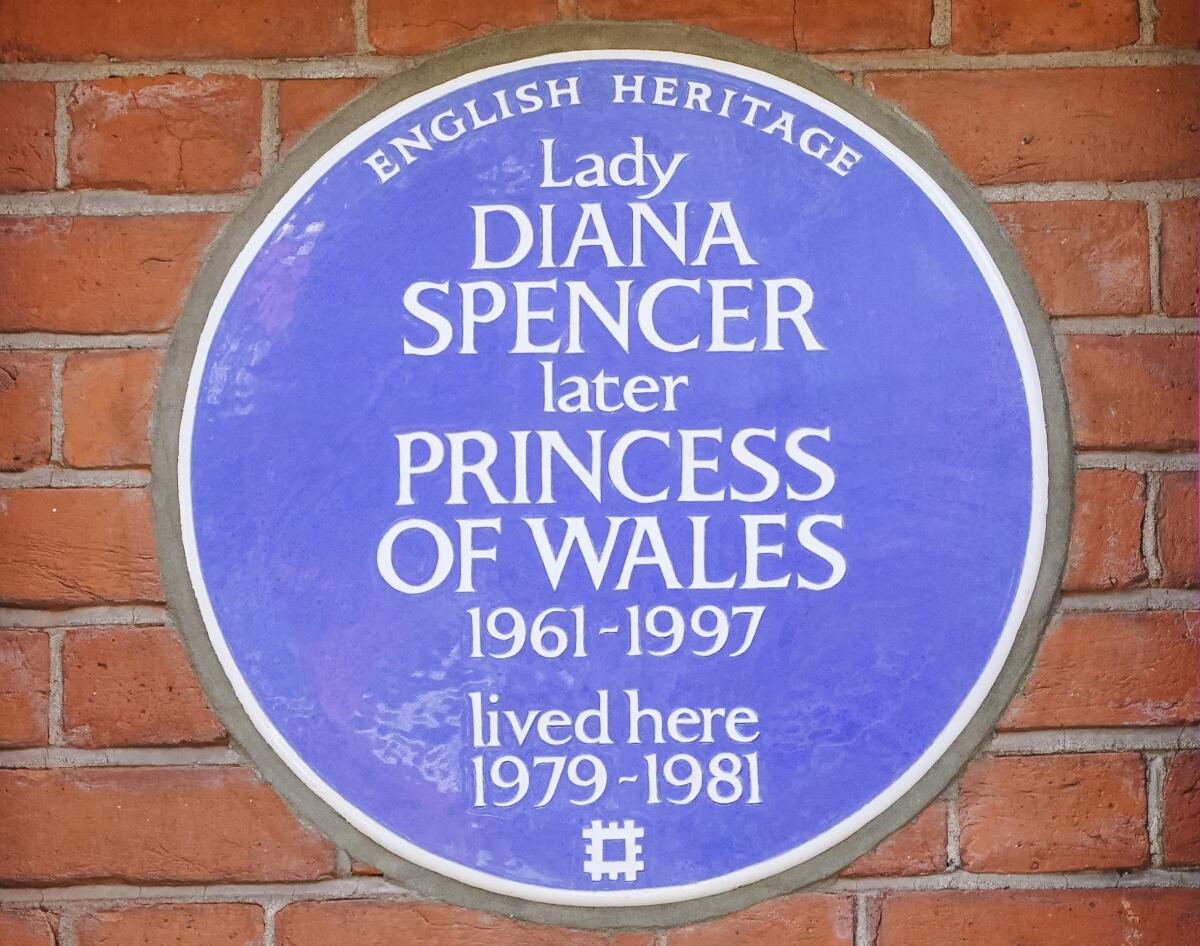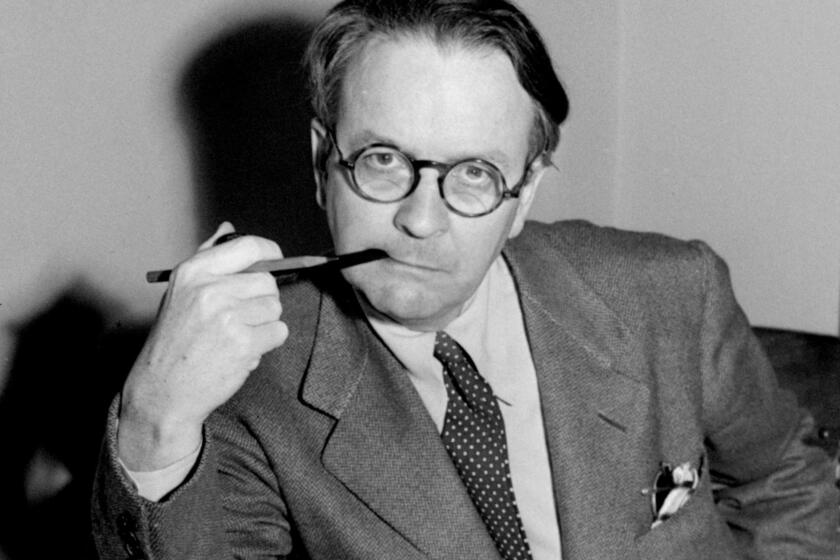Jimi Hendrix slept here: London’s famous blue plaques try for more diversity

- Share via
LONDON — A resounding thump breaks the silence as Julia Land drops a lump of gray-brown clay onto the slab roller before Ned Heywood cranks it through the machine once, twice, three times, creating a rectangle about an inch thick.
Laying a pattern on top of the slab, Heywood slices through the clay to create a disc the size of an extra-large pizza that will become one of the famous blue plaques that dot the walls of buildings throughout London, marking the places where scientists, artists, politicians and activists have made history.
As English Heritage unveiled its 1,000th blue plaque Tuesday, the charity has been working to broaden the program to include more women, people from ethnic minority backgrounds and community groups so that it better reflects the diversity of the British capital.
The latest installation marks the offices where the Women’s Freedom League “campaigned for women’s equality” in the early 20th century.

“The names are no longer just English names, which is significant because, you know, the people who’ve come to this country from all over the world have made a disproportionately large contribution,” Heywood says at his workshop, a converted 18th century pub in the Welsh town of Chepstow, 110 miles west of London. “It’s changing now, which is very much for the good.”
The blue plaque program, which began in 1866 and is believed to be the first of its kind, provides an informal historical walking tour of London that commemorates notable people and their accomplishments by highlighting the places where they lived and worked.
For almost 150 years, the storied blue English Heritage plaques have been posted around the city of London marking the homes of its most famous and influential residents.
The honorees include famous figures such as wartime Prime Minister Winston Churchill and communist pioneer Karl Marx, and lesser-known figures such as theatrical wigmaker Willy Clarkson and civil engineer William Lindley, who built water and sewage systems around the world. There are also plaques honoring foreigners such as India’s first prime minister, Jawaharlal Nehru, and American rock star Jimi Hendrix, who lived in London only briefly.
But English Heritage, which has sponsored the program since 1986, is concerned that past honorees were overwhelmingly white and male. Just 15% of the plaques honor women, and less than 5% celebrate people from Black and Asian backgrounds.
The charity, which manages about 400 monuments, medieval castles, Roman forts and country houses around England, is trying to encourage more nominations of women and people from ethnic minority groups, while retaining high standards for entry into the exclusive club, said Anna Eavis, the curatorial director.
Plaques unveiled recently honor Princess Sophia Duleep Singh, a suffragette and critic of British rule in India; Ottobah Cugoano, a native of present-day Ghana who was enslaved in Grenada and campaigned against slavery after gaining his freedom; and Ada Salter, the first woman to be elected mayor of a London borough.
Charles is an open book compared to his mother, Queen Elizabeth II. And not only is the country he serves as monarch demographically and economically different, its enthusiasm for the crown has waned.
“London is hugely diverse and it has always been, hasn’t it?” Eavis said. “And so it is important to ensure that we’re reflecting that diversity, that richness of contribution on London streets.″
Diana Yeh, a senior lecturer in sociology at City University of London, said broadening the reach of programs like the blue plaques is “an essential part of remembering invisible histories.” But heritage organizations must do more to discuss the “troubling aspects” of English history, including slavery and colonialism, she added.
“In a way, it’s very easy to celebrate well-known figures who are marginalized, but it’s much harder to do that difficult work of acknowledging Britain’s difficult past,” said Yeh, whose work focuses on race, racism and cultural politics. “But this needs to be done for the benefit of future generations.”

English Heritage installs a dozen blue plaques each year, selected from about 100 nominations. A committee reviews the nominees to decide which ones warrant commemoration and to ensure that there is a real connection between each honoree and the site where the plaque is to be installed.
Once a decision is made, the order goes out to Heywood’s studio, which has been making plaques for English Heritage since 2016. Over a period of six weeks, Heywood and Land roll and cut the clay, inscribe the disc with the honoree’s name and accomplishments, then apply the signature blue glaze and fire it in a kiln.
The first plaque, honoring the poet Lord Byron, was destroyed when the building it adorned was demolished, but the second, installed in 1867, still marks the house where Napoleon III, the last French emperor, lived in exile.
The couple’s allegations of racism in the royal family have raised questions in nations with historic ties to Britain, many of them former colonies.
Plaque No. 1,000 honors the Women’s Freedom League, a suffragist organization that used 1 Robert St. in Central London as its base of operations during its most active period.
The league was formed in 1907 by campaigners who broke away from the more famous Women’s Social and Political Union over disagreements with its leader, Emmeline Pankhurst.
The group, which had the motto “Dare to be free,” aimed for total emancipation for women. It advocated nonpayment of taxes and backed a boycott of the 1911 census as ways to pressure the government to allow women to vote. In 1909, when women’s suffrage was omitted from the King’s Speech outlining the government’s legislative program, the league hired an airship to drop pamphlets over the capital.
Heywood and Land feel the responsibility of the blue plaques intensely. To get in the right mind-set, they sometimes try to channel the honorees.
Start your day right
Sign up for Essential California for the L.A. Times biggest news, features and recommendations in your inbox six days a week.
You may occasionally receive promotional content from the Los Angeles Times.
“I’m very aware of the history of this town, the country, and aware of the changes that individuals have brought within society,″ Heywood said, surrounded by his tools, clay and dust.
“Blue plaques are carefully considered, the people are thoroughly researched and the plaques are there for a reason,” he added. “And will be there forever.”
More to Read
Sign up for Essential California
The most important California stories and recommendations in your inbox every morning.
You may occasionally receive promotional content from the Los Angeles Times.
















